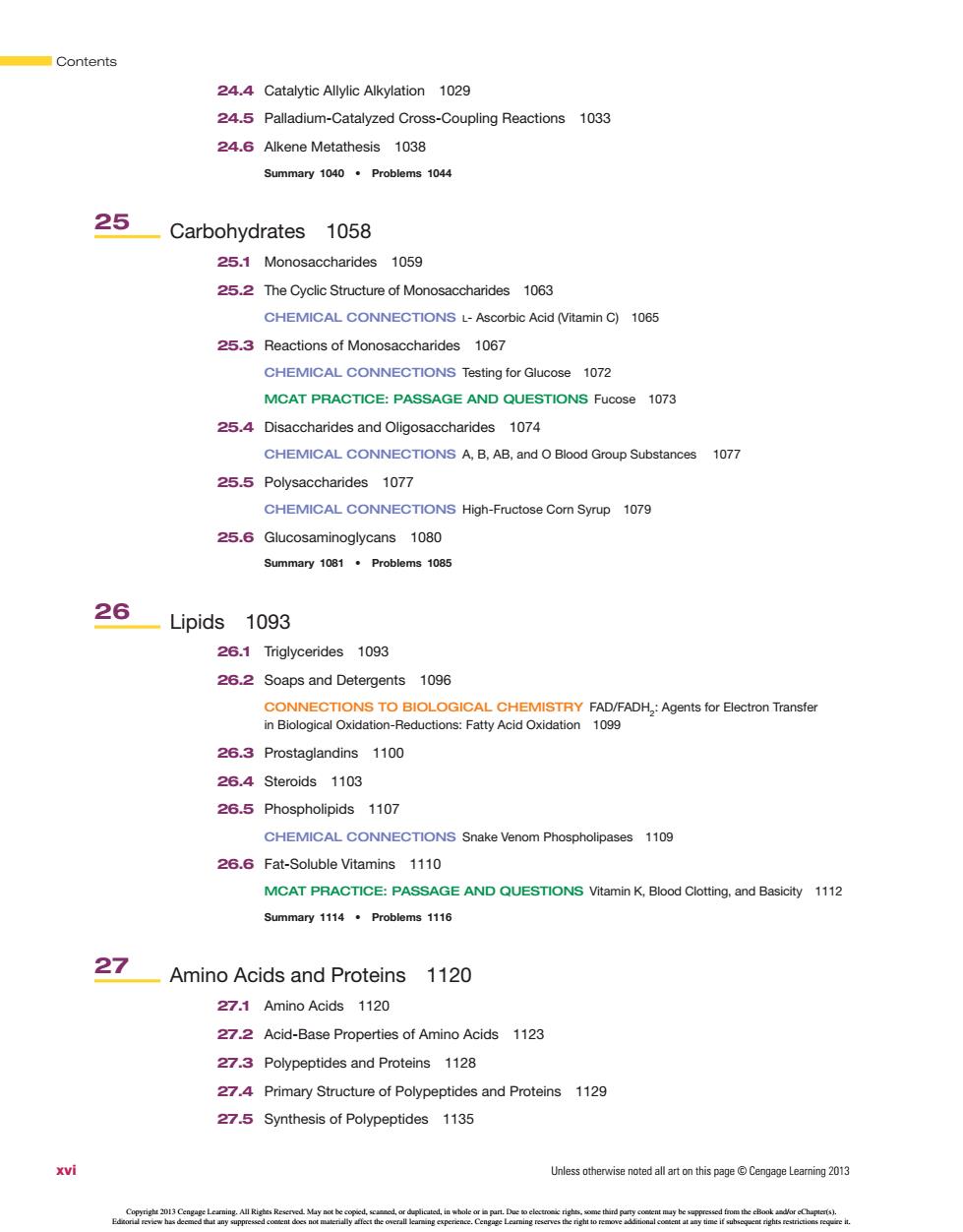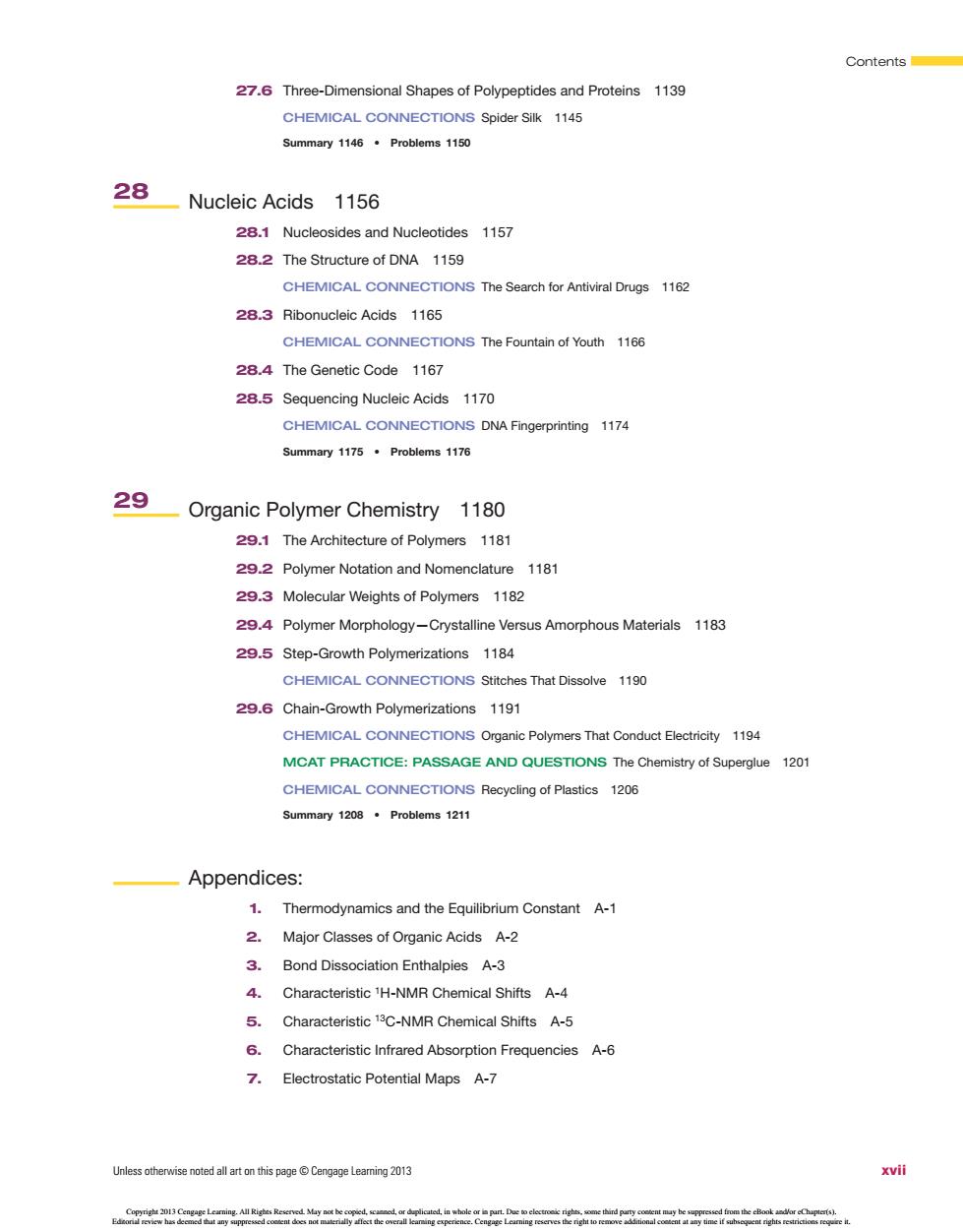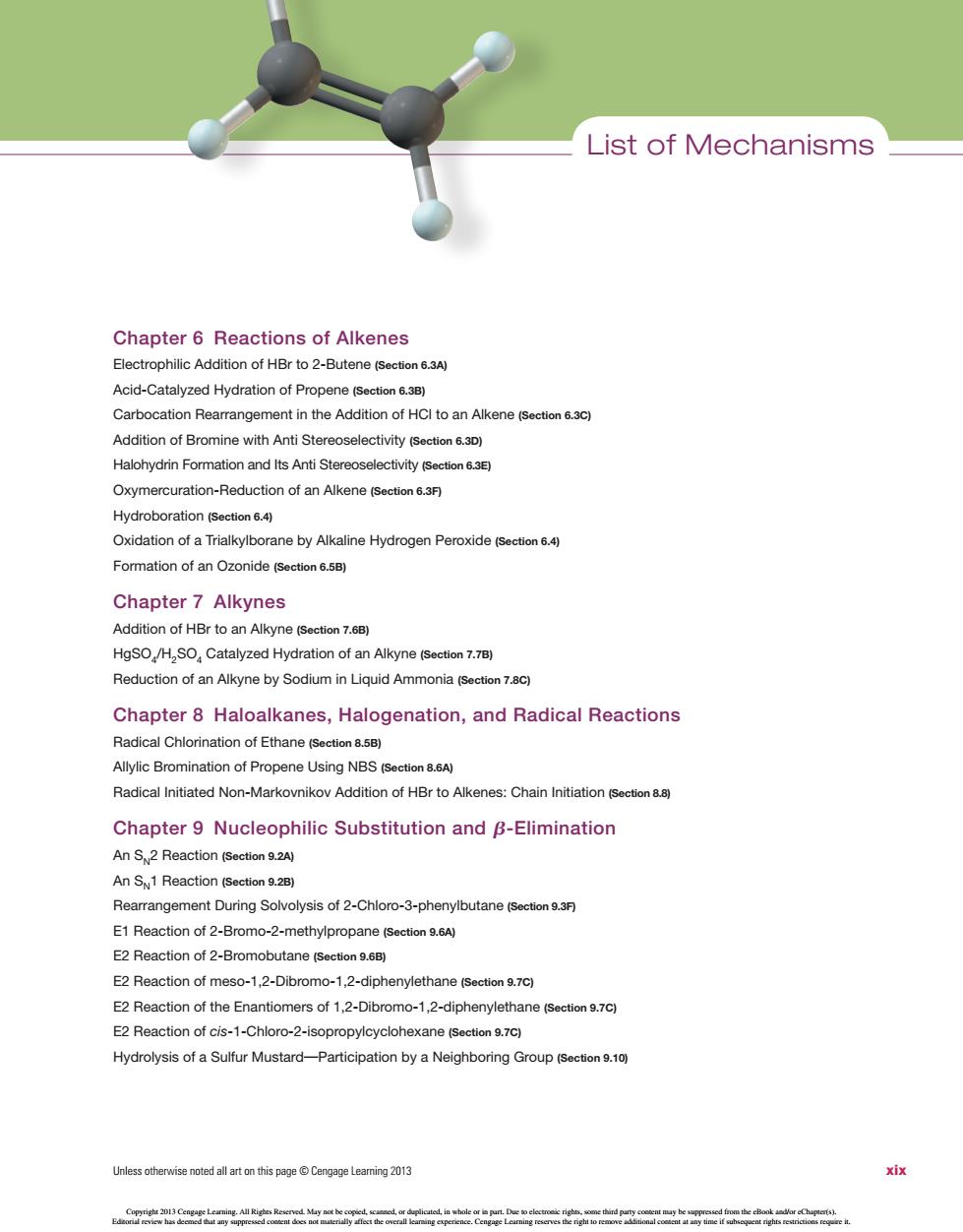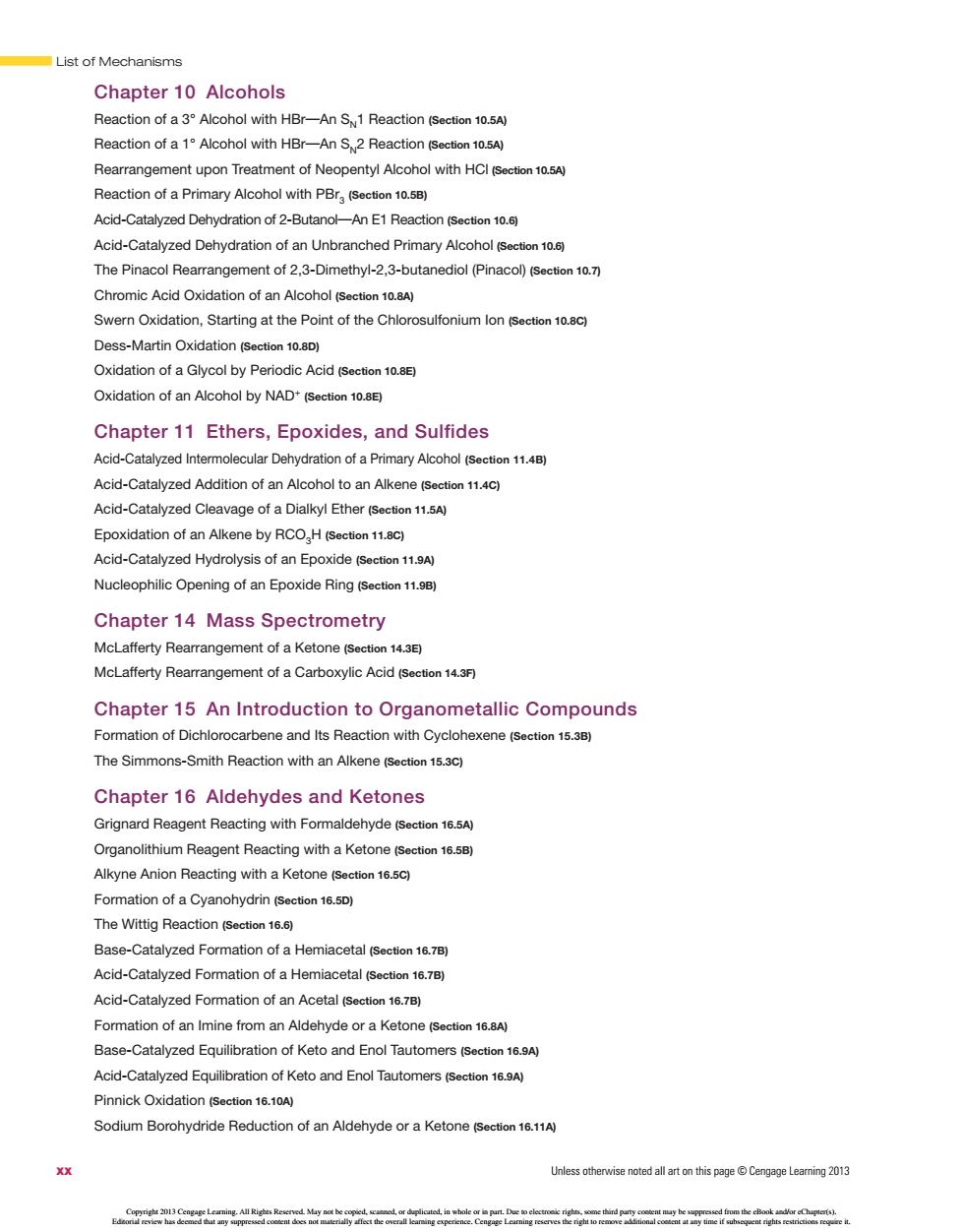
Contents 24.4 Catalytic Allylic Alkylation 1029 24.5 Palladium-Catalyzed Cross-Coupling Reactions 1033 24.6 Alkene Metathesis 1038 Summary 1040 Problems 1044 25 Carbohydrates 1058 25.1 Monosaccharides 1059 25.2 The CyclicStructure of Monosaccharides 1063 CHEMICAL CONNECTIONS L-Ascorbic Acid (Vitamin C)1065 25.3 Reactions of Monosaccharides 1067 CHEMICAL CONNECTIONS Testing for Glucose 1072 MCAT PRACTICE:PASSAGE AND QUESTIONS Fucose 1073 25.4 Disaccharides and Oligosaccharides 1074 CHEMICAL CONNECTIONS A,B,AB,and O Blood Group Substances 1077 25.5 Polysaccharides 1077 CHEMICAL CONNECTIONS High-Fructose Com Syrup 1079 25.6 Glucosaminoglycans 1080 Summary 1081.Problems 1085 26 Lipids 1093 26.1 Triglycerides 1093 26.2 Soaps and Detergents 1096 26.3 Prostaglandins 1100 26.4 Steroids 1103 26.5 Phospholipids 1107 CHEMICAL CONNECTIONS Snake Venom Phospholipases 1109 26.6 Fat-Soluble Vitamins 1110 MCAT PRACTICE:PASSAGE AND QUESTIONS Vitamin K,Blood Clotting,and Basicity 1112 Summary 1114.Problems 1116 27 Amino Acids and Proteins 1120 27.1 Amino Acids 1120 27.2 Acid-Base Properties of Amino Acids 1123 27.3 Polypeptides and Proteins 1128 27.4 Primary Structure of Polypeptides and Proteins 1129 27.5 Synthesis of Polypeptides 1135 xvi Unless otherwise noted all art on this pageCengage Learning 2013
Unless otherwise noted all art on this page © Cengage Learning 2013 Contents xvi 24.4 Catalytic Allylic Alkylation 1029 24.5 Palladium-Catalyzed Cross-Coupling Reactions 1033 24.6 Alkene Metathesis 1038 Summary 1040 • Problems 1044 25 Carbohydrates 1058 25.1 Monosaccharides 1059 25.2 The Cyclic Structure of Monosaccharides 1063 CHEMICAL ConnECTIonS l- Ascorbic Acid (Vitamin C) 1065 25.3 Reactions of Monosaccharides 1067 CHEMICAL ConnECTIonS Testing for Glucose 1072 MCAT PrACTICE: PASSAgE And QuESTIonS Fucose 1073 25.4 Disaccharides and Oligosaccharides 1074 CHEMICAL ConnECTIonS A, B, AB, and O Blood Group Substances 1077 25.5 Polysaccharides 1077 CHEMICAL ConnECTIonS High-Fructose Corn Syrup 1079 25.6 Glucosaminoglycans 1080 Summary 1081 • Problems 1085 26 Lipids 1093 26.1 Triglycerides 1093 26.2 Soaps and Detergents 1096 ConnECTIonS To BIoLogICAL CHEMISTry FAD/FADH2: Agents for Electron Transfer in Biological Oxidation-Reductions: Fatty Acid Oxidation 1099 26.3 Prostaglandins 1100 26.4 Steroids 1103 26.5 Phospholipids 1107 CHEMICAL ConnECTIonS Snake Venom Phospholipases 1109 26.6 Fat-Soluble Vitamins 1110 MCAT PrACTICE: PASSAgE And QuESTIonS Vitamin K, Blood Clotting, and Basicity 1112 Summary 1114 • Problems 1116 27 Amino Acids and Proteins 1120 27.1 Amino Acids 1120 27.2 Acid-Base Properties of Amino Acids 1123 27.3 Polypeptides and Proteins 1128 27.4 Primary Structure of Polypeptides and Proteins 1129 27.5 Synthesis of Polypeptides 1135 Copyright 2013 Cengage Learning. All Rights Reserved. May not be copied, scanned, or duplicated, in whole or in part. Due to electronic rights, some third party content may be suppressed from the eBook and/or eChapter(s). Editorial review has deemed that any suppressed content does not materially affect the overall learning experience. Cengage Learning reserves the right to remove additional content at any time if subsequent rights restrictions require it

Contents 27.6 Three-Dimensional Shapes of Polypeptides and Proteins 1139 CHEMICAL CONNECTIONS Spider Silk 1145 Summary 1146.Problems 1150 28 _Nucleic Acids 1156 28.1 Nucleosides and Nucleotides 1157 28.2 The Structure of DNA 1159 CHEMICAL CONNECTIONS The Search for Antiviral Drugs 1162 28.3 Ribonucleic Acids 1165 CHEMICAL CONNECTIONS The Fountain of Youth 1166 28.4 The Genetic Code 1167 28.5 Sequencing Nucleic Acids 1170 CHEMICAL CONNECTIONS DNA Fingerprinting 1174 Summary 1175.Problems 1176 29Organic Polymer Chemistry 1180 29.1 The Architecture of Polymers 1181 29.2 Polymer Notation and Nomenclature 1181 29.3 Molecular Weights of Polymers 1182 29.4 Polymer Morphology-Crystalline Versus Amorphous Materials 1183 29.5 Step-Growth Polymerizations 1184 CHEMICAL CONNECTIONS Stitches That Dissolve 1190 29.6 Chain-Growth Polymerizations 1191 CHEMICAL CONNECTIONS Organic Polymers That Conduct Electricity 1194 MCAT PRACTICE:PASSAGE AND QUESTIONS The Chemistry of Superglue 1201 CHEMICAL CONNECTIONS Recycling of Plastics 1206 Summary 1208.Problems 1211 Appendices: 1.Thermodynamics and the Equilibrium Constant A-1 2.Major Classes of Organic Acids A-2 3.Bond Dissociation Enthalpies A-3 4. Characteristic 'H-NMR Chemical Shifts A-4 5.Characteristic 1C-NMR Chemical Shifts A-5 6.Characteristic Infrared Absorption Frequencies A-6 7.Electrostatic Potential Maps A-7 Unessisotel artnpe3 xvii
Unless otherwise noted all art on this page © Cengage Learning 2013 Contents xvii 27.6 Three-Dimensional Shapes of Polypeptides and Proteins 1139 CHEMICAL ConnECTIonS Spider Silk 1145 Summary 1146 • Problems 1150 28 Nucleic Acids 1156 28.1 Nucleosides and Nucleotides 1157 28.2 The Structure of DNA 1159 CHEMICAL ConnECTIonS The Search for Antiviral Drugs 1162 28.3 Ribonucleic Acids 1165 CHEMICAL ConnECTIonS The Fountain of Youth 1166 28.4 The Genetic Code 1167 28.5 Sequencing Nucleic Acids 1170 CHEMICAL ConnECTIonS DNA Fingerprinting 1174 Summary 1175 • Problems 1176 29 Organic Polymer Chemistry 1180 29.1 The Architecture of Polymers 1181 29.2 Polymer Notation and Nomenclature 1181 29.3 Molecular Weights of Polymers 1182 29.4 Polymer Morphology—Crystalline Versus Amorphous Materials 1183 29.5 Step-Growth Polymerizations 1184 CHEMICAL ConnECTIonS Stitches That Dissolve 1190 29.6 Chain-Growth Polymerizations 1191 CHEMICAL ConnECTIonS Organic Polymers That Conduct Electricity 1194 MCAT PrACTICE: PASSAgE And QuESTIonS The Chemistry of Superglue 1201 CHEMICAL ConnECTIonS Recycling of Plastics 1206 Summary 1208 • Problems 1211 Appendices: 1. Thermodynamics and the Equilibrium Constant A-1 2. Major Classes of Organic Acids A-2 3. Bond Dissociation Enthalpies A-3 4. Characteristic 1H-NMR Chemical Shifts A-4 5. Characteristic 13C-NMR Chemical Shifts A-5 6. Characteristic Infrared Absorption Frequencies A-6 7. Electrostatic Potential Maps A-7 Copyright 2013 Cengage Learning. All Rights Reserved. May not be copied, scanned, or duplicated, in whole or in part. Due to electronic rights, some third party content may be suppressed from the eBook and/or eChapter(s). Editorial review has deemed that any suppressed content does not materially affect the overall learning experience. Cengage Learning reserves the right to remove additional content at any time if subsequent rights restrictions require it

Contents 8.Summary of Stereochemical Terms A-8 9.Summary of the Rules of Nomenclature A-11 10.Common Mistakes in Arrow Pushing A-18 11.Organic Chemistry Road Maps Inser Glossary G-1 Index I-1 nessothwiseoted all arthspageemng3
Unless otherwise noted all art on this page © Cengage Learning 2013 Contents xviii 8. Summary of Stereochemical Terms A-8 9. Summary of the Rules of Nomenclature A-11 10. Common Mistakes in Arrow Pushing A-18 11. Organic Chemistry Road Maps Insert Glossary G-1 Index I-1 Copyright 2013 Cengage Learning. All Rights Reserved. May not be copied, scanned, or duplicated, in whole or in part. Due to electronic rights, some third party content may be suppressed from the eBook and/or eChapter(s). Editorial review has deemed that any suppressed content does not materially affect the overall learning experience. Cengage Learning reserves the right to remove additional content at any time if subsequent rights restrictions require it

List of Mechanisms Chapter 6 Reactions of Alkenes Electrophilic Addition of HBr to 2-Butene (section 6.3A) Acid-Catalyzed Hydration of Propene Carbocation Rearrangement in the Addition of HCI to an Alkene (section 6.3c) Addition of Bromine with Anti Stereoselectivity (section 6.3D) Halohydrin Formation and Its Anti Stereoselectivity Oxymercuration-Reduction of an Alkene (Section s.3F) Hydroboration ctin) Oxidation of a Trialkylborane by Alkaline Hydrogen Peroxide (Setion.4) Formation of an Ozonide (Section 6.5B) Chapter 7 Alkynes Addition of HBr to an Alkyne (section 7.68) Catalyzed Hydration of an Alkyne (.7B) Reduction of an Alkyne by Sodium in Liquid Ammonia (section7.8c) Chapter 8 Haloalkanes,Halogenation,and Radical Reactions Radical Chlorination of Ethane (Section 8.B) Allylic Bromination of Propene Using Radical Initiated Non-Markovnikov Addition of HBr to Alkenes:Chain Initiation i Chapter 9 Nucleophilic Substitution and B-Elimination An S2 Reaction (Section 9.2A) An Sy1 Reaction (Section 9.2B) Rearrangement During Solvolysis of 2-Chloro-3-phenylbutane (.3F) E1 Reaction of 2-Bromo-2-methylpropane (Section .6A) E2 Reaction of 2-Bromobutane E2 Reaction of meso-1.2-Dibromo-1.2-diphenylethane (section 9.7c) E2 Reaction of the Enantiomers of 1,2-Dibromo-12-diphenylethane E2 Reaction of cis-1-Chloro-2-isopropylcyclohexane (tin. Hydrolysis of a Sulfur Mustard-Participation by a Neighboring Group (section 9.10 UhesohewitnotedalafomhisgeeCegageLeaming2013 xix
Unless otherwise noted all art on this page © Cengage Learning 2013 xix Chapter 6 Reactions of Alkenes Electrophilic Addition of HBr to 2-Butene (Section 6.3A) Acid-Catalyzed Hydration of Propene (Section 6.3B) Carbocation Rearrangement in the Addition of HCl to an Alkene (Section 6.3C) Addition of Bromine with Anti Stereoselectivity (Section 6.3D) Halohydrin Formation and Its Anti Stereoselectivity (Section 6.3E) Oxymercuration-Reduction of an Alkene (Section 6.3F) Hydroboration (Section 6.4) Oxidation of a Trialkylborane by Alkaline Hydrogen Peroxide (Section 6.4) Formation of an Ozonide (Section 6.5B) Chapter 7 Alkynes Addition of HBr to an Alkyne (Section 7.6B) HgSO4/H2SO4 Catalyzed Hydration of an Alkyne (Section 7.7B) Reduction of an Alkyne by Sodium in Liquid Ammonia (Section 7.8C) Chapter 8 Haloalkanes, Halogenation, and Radical Reactions Radical Chlorination of Ethane (Section 8.5B) Allylic Bromination of Propene Using NBS (Section 8.6A) Radical Initiated Non-Markovnikov Addition of HBr to Alkenes: Chain Initiation (Section 8.8) Chapter 9 Nucleophilic Substitution and b-Elimination An SN2 Reaction (Section 9.2A) An SN1 Reaction (Section 9.2B) Rearrangement During Solvolysis of 2-Chloro-3-phenylbutane (Section 9.3F) E1 Reaction of 2-Bromo-2-methylpropane (Section 9.6A) E2 Reaction of 2-Bromobutane (Section 9.6B) E2 Reaction of meso-1,2-Dibromo-1,2-diphenylethane (Section 9.7C) E2 Reaction of the Enantiomers of 1,2-Dibromo-1,2-diphenylethane (Section 9.7C) E2 Reaction of cis-1-Chloro-2-isopropylcyclohexane (Section 9.7C) Hydrolysis of a Sulfur Mustard!Participation by a Neighboring Group (Section 9.10) List of Mechanisms Copyright 2013 Cengage Learning. All Rights Reserved. May not be copied, scanned, or duplicated, in whole or in part. Due to electronic rights, some third party content may be suppressed from the eBook and/or eChapter(s). Editorial review has deemed that any suppressed content does not materially affect the overall learning experience. Cengage Learning reserves the right to remove additional content at any time if subsequent rights restrictions require it

List of Mechanisms Chapter 10 Alcohols Reaction of a 3 Alcohol with HBr-An s..1 Reaction (section 10.5A Reaction of with Rearrangement upon Treatment of Neopentyl Alcohol with HCl (Section 10.5A Reaction of a Primary Alcohol with PBra (.) Acid-Catalyzed Dehydration of 2-Butanol-An E1 Reaction (section 10.6) Acid-Catalyzed Dehydration of an Unbranched Primary Alcohol The Pinacol Rearrangement of 2,3-Dimethyl-2,3-butanediol (Pinacol)(1. Chromic Acid Oxidation of an Alcohol (Section 10.8A) Swern Oxidation,Starting at the Point of the Chlorosulfonium lon. Dess-Martin Oxidation (Section 10.8D) Oxidation of a glvcol by Periodic Acid (section 10.8E Oxidation of an Alcohol by NAD ( Chapter 11 Ethers,Epoxides,and Sulfides Acid-Catalyzed Intermolecular Dehydration of a Primary.B) Acid-Catalyzed Addition of an Alcohol to an Alkene (section 11.4c) Acid-Catalyzed Cleavage of a Dialkyl Ether.A Epoxidation of an Alkene by RCO.H (Section 11.8c) Acid-Catalyzed Hydrolysis of an Epoxide (.A) Nucleophilic Opening of an Epoxide Ring (Section 11.9B Chapter 14 Mass Spectrometry McLafferty Rearrangement of a Ketone (Section 14.3E) McLafferty Rearrangement of a Carboxylic Acid (section 14.3F) Chapter 15 An Introduction to Organometallic Compounds Formation of Dichlorocarbene and Its Reaction with Cyclohexene (section 15.3B) The Simmons-Smith Reaction with an Alkene (Section15.3c Chapter 16 Aldehydes and Ketones Grignard Reagent Reacting with Formaldehyde (.A Organolithium Reagent Reacting with a Ketone(Section 16.5B) Alkyne Anion Reacting with a Ketone (.c Formation of a Cyanohydrin (Section 16.5D) The Wittig Reaction (Section 16.6) Base-Catalyzed Formation of a Hemiacetal ( Acid-Catalyzed Formation of a Hemiacetal (Section16.7B) Acid-Catalyzed Fommation of an Acetal Formation of an Imine from an Aldehyde or a Ketone (Section 16.8A) Base-Catalyzed Equilibration of Keto and Enol Tautomers (section 16.9A Acid-Catalyzed Equilibration of Keto and Enol Tautomers) Pinnick Oxidation (section 16.10A) Sodium Borohydride Reduction of an Aldehyde ora Ketone. XX Unless otherwise noted all art on this pageCengage Learning 2013
Unless otherwise noted all art on this page © Cengage Learning 2013 List of Mechanisms xx Chapter 10 Alcohols Reaction of a 3° Alcohol with HBr!An SN1 Reaction (Section 10.5A) Reaction of a 1° Alcohol with HBr!An SN2 Reaction (Section 10.5A) Rearrangement upon Treatment of Neopentyl Alcohol with HCl (Section 10.5A) Reaction of a Primary Alcohol with PBr3 (Section 10.5B) Acid-Catalyzed Dehydration of 2-Butanol!An E1 Reaction (Section 10.6) Acid-Catalyzed Dehydration of an Unbranched Primary Alcohol (Section 10.6) The Pinacol Rearrangement of 2,3-Dimethyl-2,3-butanediol (Pinacol) (Section 10.7) Chromic Acid Oxidation of an Alcohol (Section 10.8A) Swern Oxidation, Starting at the Point of the Chlorosulfonium Ion (Section 10.8C) Dess-Martin Oxidation (Section 10.8D) Oxidation of a Glycol by Periodic Acid (Section 10.8E) Oxidation of an Alcohol by NAD+ (Section 10.8E) Chapter 11 Ethers, Epoxides, and Sulfides Acid-Catalyzed Intermolecular Dehydration of a Primary Alcohol (Section 11.4B) Acid-Catalyzed Addition of an Alcohol to an Alkene (Section 11.4C) Acid-Catalyzed Cleavage of a Dialkyl Ether (Section 11.5A) Epoxidation of an Alkene by RCO3H (Section 11.8C) Acid-Catalyzed Hydrolysis of an Epoxide (Section 11.9A) Nucleophilic Opening of an Epoxide Ring (Section 11.9B) Chapter 14 Mass Spectrometry McLafferty Rearrangement of a Ketone (Section 14.3E) McLafferty Rearrangement of a Carboxylic Acid (Section 14.3F) Chapter 15 An Introduction to Organometallic Compounds Formation of Dichlorocarbene and Its Reaction with Cyclohexene (Section 15.3B) The Simmons-Smith Reaction with an Alkene (Section 15.3C) Chapter 16 Aldehydes and Ketones Grignard Reagent Reacting with Formaldehyde (Section 16.5A) Organolithium Reagent Reacting with a Ketone (Section 16.5B) Alkyne Anion Reacting with a Ketone (Section 16.5C) Formation of a Cyanohydrin (Section 16.5D) The Wittig Reaction (Section 16.6) Base-Catalyzed Formation of a Hemiacetal (Section 16.7B) Acid-Catalyzed Formation of a Hemiacetal (Section 16.7B) Acid-Catalyzed Formation of an Acetal (Section 16.7B) Formation of an Imine from an Aldehyde or a Ketone (Section 16.8A) Base-Catalyzed Equilibration of Keto and Enol Tautomers (Section 16.9A) Acid-Catalyzed Equilibration of Keto and Enol Tautomers (Section 16.9A) Pinnick Oxidation (Section 16.10A) Sodium Borohydride Reduction of an Aldehyde or a Ketone (Section 16.11A) Copyright 2013 Cengage Learning. All Rights Reserved. May not be copied, scanned, or duplicated, in whole or in part. Due to electronic rights, some third party content may be suppressed from the eBook and/or eChapter(s). Editorial review has deemed that any suppressed content does not materially affect the overall learning experience. Cengage Learning reserves the right to remove additional content at any time if subsequent rights restrictions require it